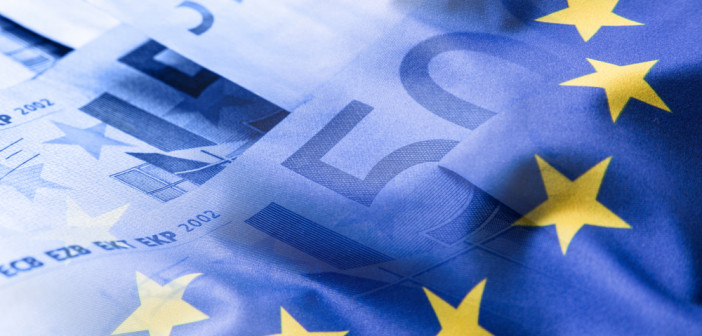A mix of big spending and big government has helped the U.S. avoid Europe’s post-pandemic struggles.
The Old World has new problems. Over the course of 2023, the European economy saw close to zero growth. The continent’s two largest national economies—Germany and the U.K.—may both be in recession. Flagship European companies such as Volkswagen, Nokia, and UBS have collectively announced tens of thousands of layoffs. Angry farmers are currently blockading roads in and out of Paris, and tens of thousands of German transport workers have recently walked off the job. The approval ratings of some European heads of state make Joe Biden look like JFK. And recent polling shows that support for far-right parties is surging across the continent, with the “cost-of-living crisis” cited as voters’ top issue.
This was all supposed to happen to the U.S. too—but it didn’t. Eighteen months ago, nearly every economist, forecaster, and pundit was predicting that the combination of a global pandemic, rampant inflation, and an energy crisis would plunge both Europe and America into recession. Instead, as Europe flounders, the U.S. economy is doing spectacularly well by almost every measure (even if not all Americans seem to think so). Unemployment is at historic lows, businesses are being created at a record rate, and wages are rising fast. And America achieved this by stealing from Europe’s big-government, welfare-state playbook—and executing it better than Europe itself.
When the pandemic hit in March 2020, governments around the world opened the money taps. The U.K. and Germany spent more than $500 billion. France spent $235 billion, Italy $216 billion. But the United States was in a league of its own, spending an astonishing $5 trillion on pandemic relief. That’s more, even in today’s dollars, than America spent on the New Deal and World War II combined—and, crucially, it’s more than double what most European countries spent on pandemic relief relative to the sizes of their respective economies.
Many economists warned that such lavish spending would send inflation soaring. For a time, this appeared to be coming true. But then something unexpected happened: Inflation cooled dramatically in the U.S. beginning in the summer of 2022, while it kept rising in Europe. Pandemic stimulus turned out not to be the main cause of inflation. Instead, the U.S.’s big spending placed Americans in a far stronger position than their European counterparts. In the face of inflation, spiking energy prices, and rising interest rates, European consumers were forced to cut back. But Americans, bolstered by about $2.5 trillion in excess savings, just kept spending. Mark Zandi, the chief economist at Moody’s Analytics, argues that this “consumer firewall” allowed businesses to keep hiring, raising wages, and making the kind of investments needed to keep the economy expanding.
The difference came down not just to the quantity of public spending but also to how it was spent. Here, it was better to be lucky than good. At the start of the pandemic, Europe supported workers by paying employers to keep them on payroll, whereas the U.S., with its byzantine, fragmented unemployment system, found it easier to pay workers to stay home through expanded unemployment insurance. (The $800 billion Paycheck Protection Program was supposed to mimic the European approach, but very little of that money ended up protecting any paychecks.) Europe’s strategy was generally seen as the superior one: When the economy reopened, people there would simply return to work without the chaos of millions of people trying to find new jobs at the same time.
In fact, the chaos now appears to have been a blessing. In normal times, workers have a bias toward staying in their current jobs, even if better opportunities may be out there. But when the U.S. economy reopened, tens of millions of laid-off workers had no choice but to look for something new—and, thanks to expanded unemployment insurance and stimulus checks, they had the financial cushion to be more selective. As a result, many people found better positions than they would have if the pandemic had never happened; millions of others started their own companies.
This labor-market reshuffling, argues Adam Posen, the president of the Peterson Institute for International Economics, is the most plausible explanation for why American workers experienced a sudden spike in productivity in the second half of 2023—one that didn’t occur in Europe. “The pandemic response convinced people that government ultimately had their back,” Posen told me. “And that allowed people to take bigger risks than normal.” European-style safety nets plus some classic American bureaucratic dysfunction may have turned out to be a winning formula.
Even as the pandemic receded, America continued to out-Europe Europe. The Infrastructure Investment and Jobs Act, the CHIPS Act, and the Inflation Reduction Act, all passed in 2022, collectively funneled more than $2 trillion into infrastructure, manufacturing, and clean energy. Those bills, intended as investments in America’s long-term future, were the kind of activist economic management that European governments had long been more comfortable with. These, too, now appear to have had an unanticipated bonus: shielding the U.S. economy against the sting of rising interest rates.
Interest-rate increases are designed to reduce inflation by cooling down an entire economy, but they operate through a very particular channel: They hamstring sectors that depend a lot on debt financing, such as construction and manufacturing, an effect that then ripples outward to the broader economy. That is exactly what has happened in Europe. But in America, those same industries are booming. Companies have announced about $650 billion of investment in areas such as semiconductors and electric vehicles since 2021. Last year, private investment in building manufacturing facilities reached its highest level since 1958. “Usually those are the very industries that get crushed by higher interest rates, and that leads to a recessionary spiral,” Zandi told me. “But these bills have allowed them to stay afloat.”
The wildly different economic trajectories of the U.S. and Europe can’t be explained by policy choices alone. Russia’s invasion of Ukraine pushed energy prices up far higher in Europe than in the U.S. Still, the transatlantic gap didn’t fully open up until 2023, after the worst of the energy crisis had already passed. The divergence is better explained by how Europe and the U.S. have respectively responded to the series of economic crises since 2020. “Biden has embraced an economic agenda much closer to social-democratic traditions of Europe,” Malcolm Gooderham, the founder of the U.K.-based Elgin Advisory, told me. “And because of that, America has left Europe in the dust.”
The final irony is that America has been able to pursue this aggressive agenda only because it is America. Since 2019, the U.S. has added more than $10 trillion to the national debt; in 2023, the government spent $1.7 trillion more than it took in. That kind of deficit spending is basically unthinkable for European leaders. After the 2008 financial crash, the continent experienced a series of sovereign-debt crises so severe that they threatened to tear apart its economic union. That left many European leaders terrified of deficit spending—a stance that may have reached an unhealthy extreme. Over the past year, many European countries have been frantically cutting budgets just as their economies desperately need more spending. These decisions have angered citizens, incited anti-government protests, and helped fuel the rise of far-right parties. In Germany, the government’s recent efforts to launch a modest clean-energy-investment agenda were overturned by the courts in November for attempting to use pandemic-emergency funds to get around the country’s self-imposed debt limit. “Germany knows that it needs the same kind of fiscal policy as America,” Sander Tordoir, a senior economist at the Centre for European Reform, told me. “But it has placed a straitjacket on itself that it can’t escape.”
Most economists expect Europe’s economy to improve, however gradually, over the course of 2024. But in a world of climate change, great-power conflict, and rapid technological advances, the continent’s future will depend on how it chooses to face the economic shocks yet to come. American leaders responded to the pandemic by becoming more like Europe; now it’s Europe’s turn to become more like America.




